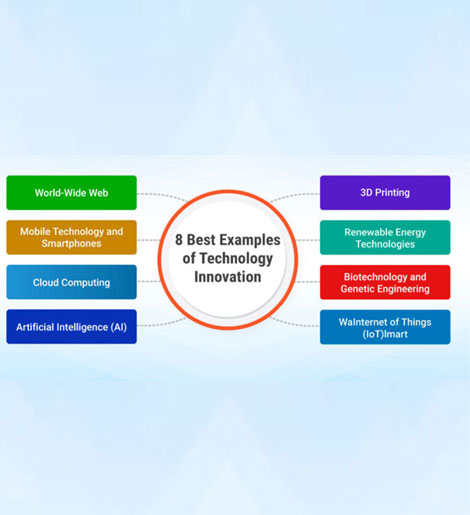
Kalyani
Foundation
Technologies and Innovative




Technologies & Innovative
Technology innovation is defined as the creation and application of new or improved technologies, tools, systems, and processes that bring about significant advancements or breakthroughs in various fields. It involves harnessing knowledge, expertise, and resources to develop innovative solutions that solve problems, improve efficiency, drive progress, and deliver value.
The importance of technology innovation can be seen in several key aspects:
- Improved Quality of Life
- Economic Growth and Competitiveness
- Enhanced Efficiency and Productivity
- Addressing Societal Challenges
- Scientific and Technological Advancement
- User Empowerment and Engagement
- Sustainable Development
8 Best Examples of Technology Innovation
World-Wide Web:
The development of the Internet and the World Wide Web revolutionized communication and information sharing. It enabled global connectivity, transformed how people access and share information, and laid the foundation for e-commerce, social media, and online services.
Mobile Technology and Smartphones:
The advent of mobile technology and smartphones brought about significant innovation. Emerging strategic innovation, it revolutionized communication by enabling portable, connected devices with advanced features like internet browsing, GPS navigation, mobile applications, and multimedia capabilities.
Cloud Computing:
Cloud computing, is the computing innovation that transformed the way computing resources are provisioned, accessed, and utilized. It provided scalable and flexible infrastructure, storage, and services on-demand, enabling businesses to leverage powerful computing capabilities without heavy upfront investments.
Artificial Intelligence (AI):
AI has witnessed remarkable innovation in recent years, leading to breakthroughs in various domains. Examples include
a. Machine Learning:
Advances in machine learning algorithms, such as deep learning, have led to significant improvements in image recognition, natural language processing, and data analysis.
b. Robotics:
Innovations in robotics and AI have brought about advancements in industrial automation, healthcare robotics, autonomous vehicles, and human-robot interaction.
c. Virtual Assistants:
AI-powered virtual assistants, such as Apple’s Siri, Google Assistant, and Amazon’s Alexa, have become increasingly sophisticated, providing natural language interactions and personalized assistance.
3D Printing:
3D printing, a technology of disruptive innovation, that is also known as additive manufacturing, has transformed manufacturing and prototyping processes. It enables the creation of complex, customized objects by building them layer by layer using various materials, offering flexibility, cost savings, and design possibilities.
Renewable Energy Technologie
Technological innovations in renewable energy, such as solar power, wind power, and energy storage systems, have transformed the energy landscape. These innovations have increased the efficiency, affordability, and accessibility of renewable energy sources, leading to reduced dependence on fossil fuels and mitigating climate change impacts.
Biotechnology and Genetic Engineering:
Advances in biotechnology and genetic engineering have revolutionized healthcare, agriculture, and environmental preservation. Innovations include gene editing technologies like CRISPR-Cas9, which enables precise modification of genes, and the development of biopharmaceuticals for personalized medicine.
Internet of Things (IoT):
a. Smart Homes:
IoT-enabled devices like thermostats, security systems, and appliances enable remote control, automation, and energy efficiency in homes.
b. Industrial IoT:
IoT technologies are used to monitor and optimize industrial processes, enabling predictive maintenance, supply chain optimization, and real-time monitoring of equipment.
Wearable Devices:
Innovations in wearable technology, such as fitness trackers and smartwatches, have enabled individuals to monitor their health, track physical activity, and receive personalized insights.

